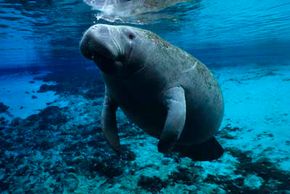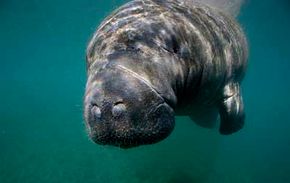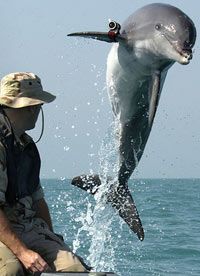Have you ever confused an onion for a pearl? Place them side by side, squint your eyes and maybe you can see the similarities. Now imagine a manatee and a mermaid swimming next to each other. The gray, bulbous creature would dwarf the slender half-fish, half-human and her flowing hair.
Yet sea lore has it that sailors used to mistake manatees for mystical mermaids. The Sirenia animal order, which includes three manatee species and one dugong species, is named after the dazzling sirens of Greek mythology [source: SeaWorld]. Dugongs closely resemble manatees, except the adult males have tusks. Manatees, with heavily whiskered snouts, flippers and blubbery physiques, have odd physical appearances. And although the description might sound like that of a walrus, the two don't bear any relation.
Advertisement
The manatee's eyeballs, positioned far back on both sides of its head, are slightly larger than marbles. On such an enormous body, the dark orbs look like slapdash thumbprints measuring just 0.7 inches (2 centimeters) in diameter. They're about half the size of human eyeballs, but manatees' bodies are four or even five times larger than ours. With a body length measuring 9.8 feet (3 meters) and a weight of 800 to 1,200 pounds (362 to 544 kilograms), their sea cow nickname fits like a glove.
These aquatic mammals live near the surface of the water in shallower depths. Many times, they won't dive any deeper than 10 feet (3 meters) in search of food. They can't breathe underwater but can hold their breath for an average of two to four minutes. Eating takes up a bulk of their time, as manatees consume 10 percent of their body weight in sea plants daily [source: Goode]. For example, manatee researchers at the University of South Florida feed a pair of captive sea cows 72 heads of lettuce and 12 bunches of kale each day [source: Goode].
With their vegetarian diet and boat-sized bodies, manatees neither need to hunt prey nor escape predators, which would be easy living if not for human activity [source: Goode]. All three manatee subspecies -- West Indian, West African and Amazonian -- are endangered. Boating and fishing significantly affects manatees because the mammals swim close to the surface of the water. According to the Florida Fish and Wildlife Conservation Commission, various types of watercraft killed 73 manatees in 2007. Florida in particular has implemented manatee protection policies such as restricted speed zones and no entry zones in certain waterways, and surveys indicate that the manatee population has increased accordingly.
But couldn't manatees see a boat moving toward them and just get out of the way, or do they swim blindly? Let's just say that when it comes to manatee senses, there's more than meets the eye.
Advertisement



